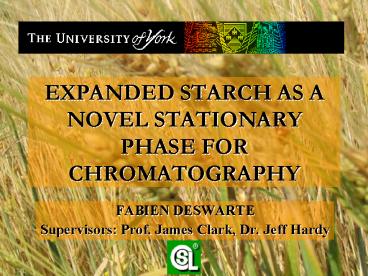EXPANDED STARCH AS A NOVEL STATIONARY PHASE FOR CHROMATOGRAPHY - PowerPoint PPT Presentation
1 / 23
Title: EXPANDED STARCH AS A NOVEL STATIONARY PHASE FOR CHROMATOGRAPHY
1
EXPANDED STARCH AS A NOVEL STATIONARY PHASE FOR
CHROMATOGRAPHY
- FABIEN DESWARTE
- Supervisors Prof. James Clark, Dr. Jeff Hardy
2
PLAN
- Background of the project
- Characterisation of expanded starch comparison
with silica - Use in Column Chromatography
- Use in Flash chromatography
- Hydrothermal stability issues solutions
3
WHAT IS STARCH ?
- One of the most abundant biopolymer on the planet
- Biopolymer of D-glucose
- 2 types of molecules
- Amylose
- linear, a-1,4 linkages
- Amylopectin
- Branched, a -1,6 linkages
- at branch points
4
EXPANSION OF STARCH
granules
5
PHYSICAL PROPERTIES
EXPANSION
Expanded starch
Type IV
Relative pressure (P/P0)
Relative pressure (P/P0)
Silica K60
Nitrogen adsorption isotherms conducted at 70K
Type IV
IUPAC recommendations, Pure Appl. Chem., 1994
(66) 1739
Relative pressure (P/P0)
6
PHYSICAL PROPERTIES
Microporous volume was calculated through the
Dubinin-Radushkevich model
Surface polarity measurement ( )obtained
using Reichardts dye as a indicator
7
PHYSICAL PROPERTIES
Microporous volume was calculated through the
Dubinin-Radushkevich model
Surface polarity measurement ( )obtained
using Reichardts dye as a indicator
8
PHYSICAL PROPERTIES
Microporous volume was calculated through the
Dubinin-Radushkevich model
Surface polarity measurement ( )obtained
using Reichardts dye as a indicator
9
SEPERATION MODEL
- Model system
20 cm
Ferrocene
Diacetyl ferrocene
Monoacetylferrocene
Elution system
- 30 ml hexane
- 45 ml hexane/acetone
(955, vv) - 30 ml acetone
Polarity
5 ml
- Collection of 5ml fractions and analysis by GC
10
EXPANDED STARCH GRAVITY CHROMATOGRAPHY
GC response (Arb. Units)
No separation
Native starch (SA lt 1 m2/g)
EXPANSION
Expanded starch (SA 138 m2/g)
Hexaneacetone (955)
Acetone
Hexane
Fractions
11
EXPANDED STARCH GRAVITY CHROMATOGRAPHY
GC response (Arb. Units)
Expanded starch (SA 138 m2/g)
Silica K60 (SA 458 m2/g)
Hexaneacetone (955)
Acetone
Hexane
Fractions
12
EXPANDED STARCH GRAVITY CHROMATOGRAPHY
13
WHEAT STRAW WAXES
Wheat straw
COSMETICS, COATINGS, ETC..
Liquid extraction
WAXES
14
PURIFICATION OF WHEAT STRAW WAXES
SILICA K60 400 mL of a (8515, vv) mixture of
hexane/ether
EXPANDED STARCH 200 mL of a (928, vv) mixture
of hexane/ether
Purification of a crude methyl-tetrahydrofuran
extract of wheat straw
15
EXPANDED STARCH FLASH CHROMATOGRAPHY
Conditions 10 mL/min Hexane ? (9010, vv)
hexane/acetone (51 mL) (9010, vv)
hexane/acetone ? acetone (51 mL)
16
HYDROTHERMAL STABILITY ISSUES
GC response (Arb. Units)
Expanded starch (SA 138 m2/g)
Saturated water vapour
50C / 24h
Hexaneacetone (955)
Acetone
Hexane
Fractions
Degraded starch (SA lt 1 m2/g)
17
HYDROTHERMAL STABILITY SOLUTION (1)
GC response (Arb. Units)
Expanded starch (SA 138 m2/g)
(a) Stored under hexane
(b) Stored in a dessicator
Hexaneacetone (955)
Acetone
Hexane
Fractions
Starch stored under hexane (SA 132 m2/g)
18
HYDROTHERMAL STABILITY SOLUTION (2)
Solvent exchange
granules
drying
19
HYDROTHERMAL STABILITY SOLUTION (2)
GC response (Arb. Units)
Expanded starch (SA 138 m2/g)
Solvent-exchanged retrograded starch
Fractions
20
HYDROTHERMAL STABILITY SOLUTION (3)
THERMOLYSIS
- Heated under vacuum
- Doped with a catalytic amount of
p-toluenesulfonic acid
21
CONCLUSIONS
- Application of expanded starch to chromatography
- Potential separation of very polar compounds such
as proteins - More work is needed to fully understand
chromatographic properties of material - Physical and chemical modifications can be
applied to modify/improve properties - Same methodology could be applied to other
biomaterials
22
Budarin V., Clark, J.H., Deswarte F.E.I., Hardy
J.J.E., Hunt A.J., Kerton F.M., Chem. Comm., 23
(2005) 2903-2905 PATENT PENDING Clark, J.H.,
Deswarte F.E.I., Hardy J.J.E., Hunt A.J., Kerton
F.M., and Milkowski K., PCT Patent Application,
PCT/GB2004/003276. July 27th 2004
23
THANKS TO
THANKS FOR YOUR ATTENTION
feid100_at_york.ac.uk































